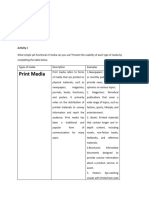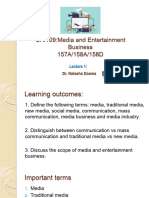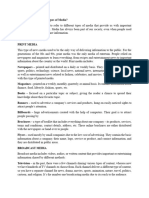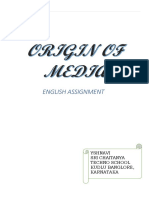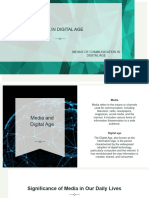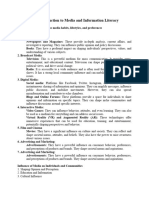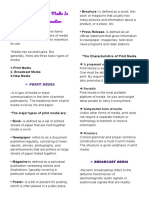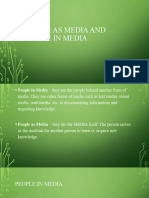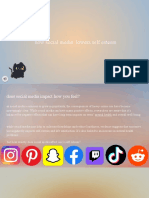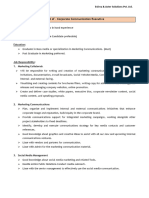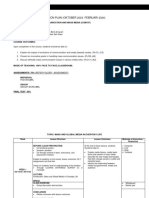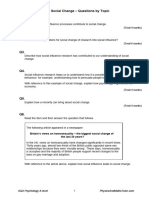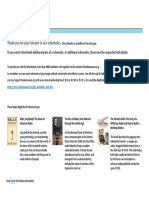What is Media?
These days you can often hear people talking about the media. Topics like social media, mass media, or
media bias are frequently discussed in personal, professional, and educational settings. We all use
various types of media in our daily lives but what does the word media actually mean? Media is the
different channels, or ways, in which news, entertainment, marketing messages or other information is
spread.
W H A T A R E T H E D IF F E R E N T T Y P E S O F ME D IA ?
There are many different types of media and they have evolved over time. Two main categories are
traditional media, such as radio, magazines and TV shows, and digital media (or new media) like the
kind people get through their computers and smartphones. While most people today are using
increasing amounts of digital media, traditional forms of media are still part of our daily lives too.
Traditional Media (print media, broadcast media, outdoor media)
See Image Credits
The term traditional media refers to any mass communication method that came before the invention
of the internet and digital media. One of the oldest types of traditional media is print media. This
includes newspapers, magazines and books. Another type of traditional media is outdoor media such as
billboards, posters, flyers and transit media. An example of transit media is an advertisement you might
see on or inside a bus. As technology developed, so did the different types of media. Broadcast media,
which covers radio and television, is a more recent addition to traditional media.
© 2021 by George Mason University. What is Media? This work is an adaptation of EML MOOC
1 Module One Packet by FHI 360 for the OPEN Program, sponsored by the U.S. Department of State
with funding from the U.S. government, licensed under the Creative Commons Attribution License. 1
Adapted content is licensed under the Creative Common Attribution-ShareAlike 2.0 Generic (CC
BY-SA 2.0). To view a copy of this license, visit https://creativecommons.org/licenses/by-sa/2.0/
�Digital Media/New Media
In the 1990’s and early 2000’s digital and internet technologies were becoming more widely used
around the world. Traditional media that had only been produced in print or broadcast formats could
now be digitized and shared over the internet. Websites and social media platforms made it easier for
users to access and share various types of media from their home computers. People could conveniently
watch videos, do internet research, read e-books and online newspapers, read and write blogs, and
share digital messages and photos via computer. More and more people started using the internet, and
social media platforms in particular, for sharing and communicating.
Social Media
Social media belongs under the digital/new media classification. Today, millions of people use social
media such as Facebook, Tik Tok and Twitter to spread their ideas and messages. Social media refers to
any website or technologies that allow individual users to create and share information with a specific
audience. Other examples of social media are Instagram, YouTube, and online discussion boards or
forums.
Mass Media
In this course, we will be talking a lot about mass media. Mass media is any type of media that is
distributed to large audiences usually via large media companies. Both traditional and digital media can
be distributed to mass audiences. Mass media can also be shared via social media platforms.
H O W D O WE E N GA GE W IT H M E D IA ?
Media Consumption
As technology has grown, the ways in which we receive media messages have changed. We read text
(written language) but we also look at pictures, data and charts. We watch videos and we listen to the
radio, podcasts, and other audio recordings. These days we often say that we consume media which can
refer to any way that we take media messages in. Reading an article, watching a video, and listening to
radio broadcasts are all examples of media consumption.
Media Production
With the development of new information and communication technologies (ICTs), along with
innovative software, people have many new and creative tools for making their own media. People can
create their own websites, write blogs, record and edit videos, take and edit photos, record music, and
make memes. These are all examples of media production which is sometimes called content creation.
2
� H O W OF T E N D O WE S E E O R H E A R ME D IA ME S S A GE S ?
Meet Diego: Read about a typical day in Diego's life.
“Untitled image” by Sasin Tipchai via Pixabay “Untitled image” by Monika Baechler via Pixabay “Untitled image” by Sifpceuc via Pixabay
is licensed under the Pixabay license. is licensed under the Pixabay license. is licensed under the Pixabay license.
Diego wakes up every morning at 7 AM. As he gets ready for the day, he listens to music on the radio.
His mom always plays her favorite station. As he takes the bus to school, Diego listens to music on his
smartphone. On the ride to school, Diego sees billboards for new cars and fast food along the roads. He
also notices advertisements for energy drinks and fast food on posters inside the bus. When Diego
arrives at school, he meets his friends outside. Diego and his friends watch videos on their phones for a
few minutes before school begins. When the bell rings, Diego goes to class with his backpack which is
full of textbooks. In his school books he sees articles, photographs and illustrations on various topics.
The teachers also have interesting posters in their classrooms. Some of the posters show images of
rocks, planets, famous people and scientific charts.
After school, Diego and his friends hang out for a while before they have to go home. They get out their
phones and look at various social media apps. Diego and his friends usually check out interesting photos
on Instagram and videos on TikTok. On one particular day they decide to make their own video. They
make a short video that shows how to do the floss dance. Diego is really good at flossing so he shows
how to do the dance while another friend records the video. Afterwards they upload it to Diego’s TikTok
account and check it frequently for likes and comments. Diego often sets his TikTok videos to public
because he wants to have a video go viral someday.
When Diego gets home, he does his homework, eats dinner and then watches some TV with his dad. If
the TV show is boring, he scrolls through TikTok or Instagram on his phone while watching TV. After he
goes to his room to go to bed, he actually stays up for another two to three hours playing video games
and chatting with his friends on his phone.
Think about your daily routine. How often do you see and hear media messages? Where do you find
these messages? Do you ever create your own media such as videos, blogs or memes? Later on, we
will introduce a media log assignment that can help you identify and analyze your students’ media use
as well as your own.
Image Credits
This image is a derivative of “Untitled Image” by ds__30; “Untitled Image” by igorovsyannykov; “Untitled Image” by Crookoo;
“Untitled Image” by Pexels; and “Untitled Image” by Foundry via Pixabay under Pixabay license; and “Jubilee Board” by Jaggery
via Geograph UK under CC BY SA. This derivative is licensed CC BY SA by FHI 360 for use in the OPEN program, sponsored by the
U.S. Department of State with funding provided by the U.S. government and administered by FHI 360.




















